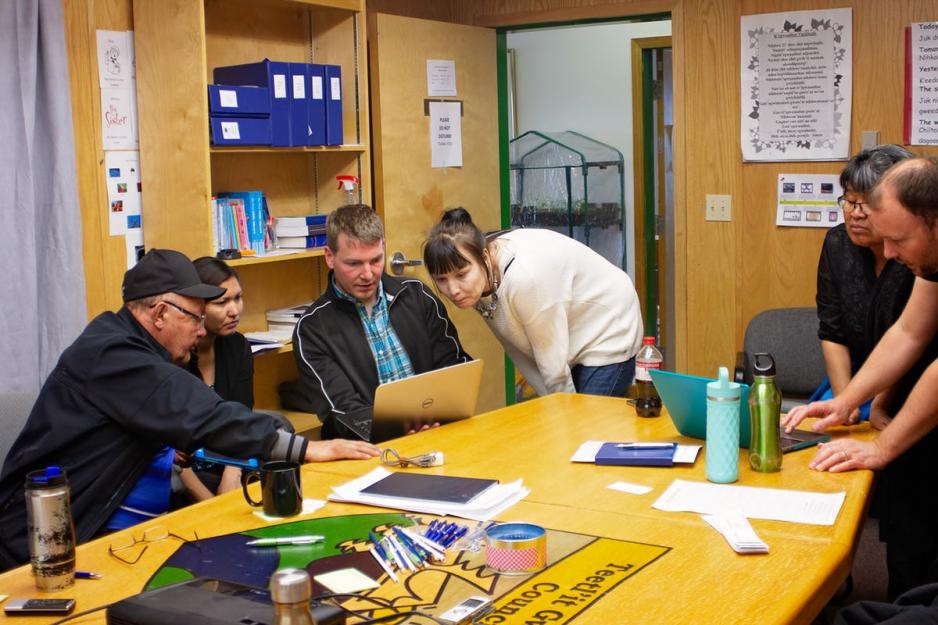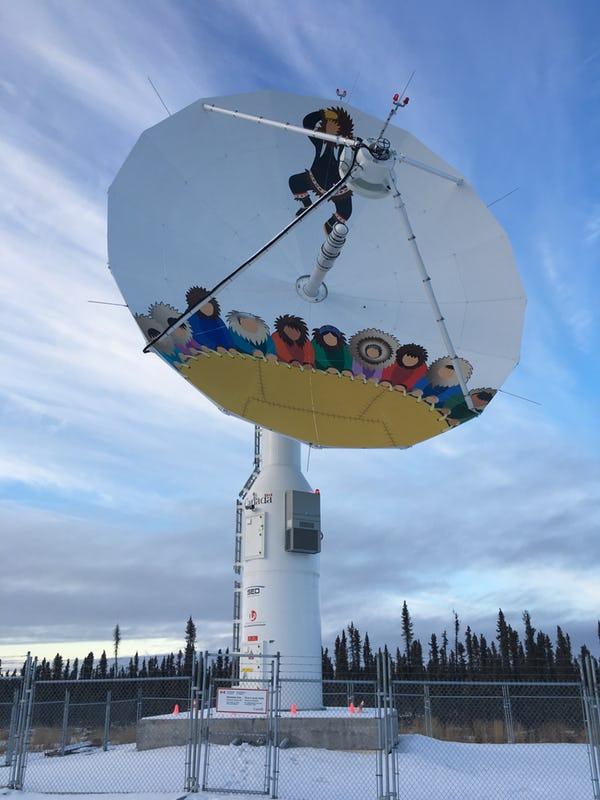Op-ed Can Smart Societies Support Innovation In the Arctic?

Members of Dinjii Zhuh (Gwich'in) communities in the Northwest Territories attending a digital literacy workshop in June 2018. (Photo: Hanne Pearce).
The Norwegian city of Tromsø annually hosts the Arctic Frontiers conference, with the 2019 edition having focused on a ‘Smart Arctic’. This focus is timely, given present interest in Smart Innovation. But what does ‘smart’ mean in Arctic contexts? And how can Northern peoples and organizations benefit from it?
This is an opinion piece written by external contributors. All views expressed are the writer's own.
Discussions of ‘Smart Societies’ in the Arctic must engage local and regional actors to shape policy and regulation to enable appropriate community and economic development initiatives. Northern governments, companies and civil society organizations are all paying increased attention to the potential of digital connectivity. Decisions regarding these systems should refer to the unique circumstances and assets of northern societies and their potential for smart specialization. Many northern regions belong to a system of economic and political relations that puts residents in uneasy tension with state and multinational influences.
In this context, perhaps the most important issue moving forward is ensuring that Arctic residents are engaged in decisions regarding circumpolar connectivity. Conditions must be put in place to identify development goals through structured planning and dialogue: leaders and administrators from urban, rural, remote and Indigenous regions must substantively engage in strategic planning regarding how digital connectivity is built, setup, owned, paid for, distributed, managed and used in and across their communities and regions.
This engages a diversity of users to make decisions on how infrastructure and bandwidth delivers essential services and supports digital economies. This involves working with Arctic residents to develop northern-specific indicators that identify and capitalize on their unique assets, while working to mitigate digital inequalities and divides.
Have you heard about Smart Cities in the Arctic?
The urban cities of the far North are expanding economic and political globalization in ways that reflect the potential of digital connectivity. For example, the northern Finnish city of Oulu has been characterized as an ideal Smart City. Located just 170 km south of the Arctic Circle, Oulu was ranked as the third ‘Silicon Valley’ in the 1990s.
The origins of the city’s digital economy can be traced to the 1980s with the development of Nokia’s Research Center and the Oulu Technology Park, which housed small-to-midsize ICT enterprises.
Despite Nokia’s demise in the 2000s, Oulu still ranks as one of the best global cities for startup companies – a well-earned reputation, given that it houses more than 600 ICT companies, some of which utilize open platforms, including a 5G test network, OuluHealth (an ‘innovation ecosystem’ to test health product developments), and a city-wide open and free wireless network (panOULU).
Oulu’s success is often explained by its ‘public-private-people-partnership approach’, part of a long tradition of co-operation between education and research institutes, companies, the public sector, and individuals. The test user forum PATIO, for example, is described as the world’s first combined citizens’ forum and ‘living lab’. It is not by accident that Oulu co-coordinates the European Union’s (EU) Partnership on Digital Transition to provide better public services to citizens around Europe.
These and other activities reflect Oulu’s evolution from ‘innovation hub’ to ‘innovation node’ in a regional urban network extending both inside and beyond Finland’s borders. Today, Oulu serves as a prime example of urban-oriented Arctic innovation that holds important lessons not only for European Arctic states, but for cities across the North. Similar discussions have also reached North Norway and the city of Bodø.
The Norwegian Air Force’s decision to move and shut down the military airport in Bodø has lead the city to reconsider their urban development plans and develop a modern, smart city in the Norwegian North. The blue economy is key to the city’s future orientation and focus of many recent and future events and discussions in Bodø; currently also highlighted in a related project coordinated by the High North Center at Nord University.

Satellite dish in Inuvik, Northwest Territories, Canada. It depicts a 'long-range scanning system' developed by Inuit peoples in the region, who would boost people up to look for animals. (Photo: Rob McMahon).
Thoughtful Indigenous Innovation in Northern Canada
Across the Arctic Ocean, very different forms of digital innovation are emerging in the small-population, geographically-dispersed communities of northern Canada. A young and growing population of Indigenous northerners are shaping digital infrastructures and services to gain more control over global development forces, as well as to drive economic and political initiatives, and sustain their cultural and linguistic practices.
Paradoxically, demand for digitally-enabled services is often strongest in regions where digital connectivity is least available; since they lack stores, hospitals, schools, and other organizations, such services are made available through digital applications. Many of these initiatives therefore do not position emergent technologies against local interests, but see them as complementary, provided the right conditions and controls are in place.
Consider Isuma, an initiative led by Inuit in Nunavut, Canada that means ‘to think, or a state of thoughtfulness’ in Inuktitut. The organization started in the mid-1980s to document stories and Inuit traditions in Igloolik, and has since expanded to a digital production and connectivity hub that retains northern roots while securing international awards.
In 2001, Isuma’s feature length film Atanarjuat: The Fast Runner won the Cannes Camera d’or, and in 2019 the organization will represent Canada at the 58th annual La Biennale di Venezia. Over the years, demand for relevant content – and a means to produce and access it – led Isuma to build a network showcasing more than 6,000 films and videos in 80 languages (over 1,300 in Inuktitut). This was done in regions of Canada where YouTube and Netflix are not yet widely available, due to inadequate and expensive connectivity.
Today, Isuma’s system allows people across Nunavut to create and access community-curated programming 24/7. It also provides a platform that enables people living across a vast stretch of the Canadian Arctic to participate in the management and governance of activities, from organizing elections and referenda, to administering a region lacking road transportation.
For example, Isuma’s live-streaming and video-uploading capabilities encourage transparency and input in resource extraction, such as during the environmental review hearings for one of the world’s largest open-pit mines at Mary River on Baffin Island. As resource exploration increases, such projects document promises, negotiations, and analysis in digital formats and appropriate languages, informing participation in regulatory processes.
Obstacles and Opportunities of Northern Innovation
Several barriers limit how Northern residents can develop and use these technologies. Deploying reliable digital infrastructures and services in the Arctic presents significant technological and financial challenges, compounded by limited market forces and political will. Digital inequalities are further impacted by high costs of connectivity and low quality of services.
But at the same time, northern and Indigenous residents have built their own digital systems. Regional providers including K-Net in Northwest Ontario and Tamaani Internet Services in Nunavik support online health, education and other public services, interconnect organizations across the North, and generate local employment.
Northern actors are also involved in data centres that store health, education, financial, scientific and many other forms of data. These centres are owned and operated by regional Indigenous groups along with internet giants like Facebook and Google that take advantage of valuable cold temperatures, since less energy is needed to cool down buildings and equipment.
Broadband-enabled applications are also developed and used by Northern organizations in various service contexts. Nordic countries were pioneers in applications like electronic data interchange in 1990s, and today the practice is widespread among smaller enterprises. More recently, financial applications have scaled to support international commerce.
In remote regions, students can attend online high schools and patients can access a range of medical specialists without having to leave their communities. Other examples include remote monitoring of water treatment plants, GIS-enabled mapping of lands and resources, and emergency responses. Economic development initiatives also derive benefits from digital connectivity: in offshore oil and gas, for example, connectivity assists in exploration, drilling, enabling safe operations and design of facilities, increasing knowledge of marine life, and mitigating environmental risks.
Vessels of all kinds use digital applications to support navigation, search and rescue, data transfer and internet access, among other uses. On land, entrepreneurs are setting up web design companies, online training initiatives, and a range of digitally-enabled cultural and media production activities.
Looking Ahead - Shaping Smart Societies through Citizen Engagement
These practices are all tied to the uniquely Arctic contexts from which they emerge: from the icy shores of Igloolik to Oulu’s Nordic Silicon Valley. Network effects can drive centralized development in better-connected, urbanized regions, and spaces within regions, while threatening to isolate nodes on the periphery.
Digital development of Smart Societies should therefore consider the management and operations of the underlying infrastructures that support locally-emergent initiatives like Isuma, as well as digital cities like Oulu. This includes a recognition of the technical barriers they face, and the policies and regulations that might assist their efforts.
In the context of Smart Societies, digital policy and regulation should frame broadband as not just a catalyst for community and economic development, but as an essential service. The Arctic Council has established task forces to improve connectivity in the Arctic and assess existing telecommunication infrastructure. In Canada, after years of advocacy by Indigenous and public interest groups, the federal regulator recently established minimum speeds and set up an infrastructure support fund to accompany other sources of public and private sector financing.
Oulu and Isuma demonstrate two notable cases of Arctic-led innovation that can benefit from this work – there are many more, developed against challenging odds, with limited access to digital resources. We challenge communities, governments, civil society organizations and private sector entities to find ways to collaborate with these initiatives, in ways that support more innovative, equitable Smart Societies for all Northerners.
This article was also published via The Arctic Institute and can be found here.
The article is based on a chapter on Digital Content and Connectivity in the Circumpolar Arctic, to be published in the forthcoming Handbook on Arctic Politics edited by Mark Nuttall and Anita Dey Nuttall.
Rob McMahon is Assistant Professor, University of Alberta and Coordinator of the First Mile Connectivity Consortium, a national association of Indigenous technology organizations serving rural, remote and Northern communities in Canada.
Andreas Raspotnik is a Senior Researcher at the High North Center where he manages the AlaskaNor project.
